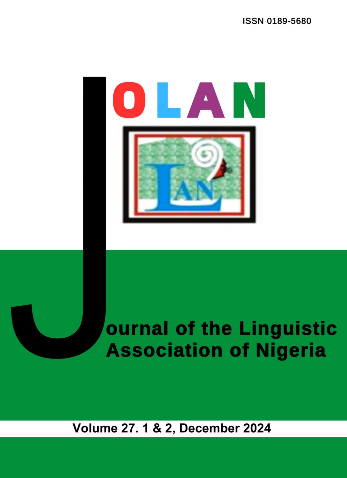Phonological processes in the non-native phonology of Akan
Keywords:
Assimilation, simplification, Akan, non-native speakers, Phonological processesAbstract
This paper seeks to investigate the phonological processes embedded in the phonology of native Ewe speakers of Akan. This study has become necessary because Akan is a lingua franca in Ghana where most people have some level of speaking and comprehension competence. However, at the early production or pre-advanced phase of L2 acquisition, the Ewe speakers of Akan encounter numerous segmental and prosodic challenges which trigger various phonological processes as resolution strategies. Therefore, this study bridges this gap in language acquisition by examining the phonological processes entrenched in the phonology of Ewe speakers acquiring Akan as their L2. The challenges usually arise from phonological dissimilarities between the L1 source phonology and the L2 target. The paper argues that the inadequacies in L2 acquisition at the pre-advanced phase trigger some phonological processes such as vowel raising and lowering, anteriorization, and de-stridentization among others as phonological simplification strategies to resolve challenging native Akan forms. The study employs focus group discussion as a data collection approach and it is formalized within the Perceptual Assimilation Model of second language learning (PAM- L2) (cf. Best 1993; Best & Tyler 2007).
References
Abakah, E. N. (2013). Vowel replacement patterns in the Mfantse dialect of Akan. Journal of Universal Language, 14 (2), 7-51.
Abakah, E. N. (2012). Some assimilatory processes in Akan. Journal of West African Languages, 39(2), 47-82.
Abakah, E. N. (2005). Where have all the consonantal phonemes of Akan gone? Journal of Philosophy and Culture, 1(2), 21-48.
Abakah, E. N. (2002). Remarks on the Akan vocalic inventory. In F.K. Ameka & E. K. Osam (Eds.), New directions in Ghanaian linguistics: Essays in honour of the 3Ds. (pp. 243-263). Black Mask.
Amoako, K. W. (2020). Assessing phonological development among Akan-speaking children. MA thesis, University of British Columbia.
Antoniou, M., Tyler, M. D., and Best, T. C. (2012). Two ways to listen: Do L2 dominan bilinguals perceive stop voicing according to language mode? Journal of Phonetics, 40, 582-594.
Best, C. T. (1995). A direct realist view of cross-language speech perception. Speech Perception and Linguistic Experience: Theoretical and Methodological issues in cross-language research. ed. By Strange, Winifred, (pp. 167-200). Timonium, MD: York Press.
Best, C. T. (1994). The emergence of native-language phonological influences in infants: A perceptual assimilation modeƖ. In J.C. Goodman & H.C. Nusbaum (Eds), The development of speech perception: The Transition from Speech Sounds to Spoken Words (pp. 167-224). MIT Press.
Best, C. T. (1993). Emergence of Ɩanguage –specific constraints in the perception of non- native speech: A window on earƖy phonological development. In B. de Boysson- Bardies, S. de Schonen, P. Jusczyk., P. McNeiƖage P., & L. Morton (Eds.), Developmental neurocognition: Speech and face processing in the first year of life (pp. 289- 304). Dordrecht.
Best, C. T. & Tyler, M. D. (2007). Non-native and second Ɩanguage speech perception: CommonaƖities and compƖementarities. In M. J. Munro, & O. S. Bohn (Eds.), Second Ɩanguage speech Ɩearning: The roƖe of Ɩanguage experience in speech perception and production (pp. 13-34). John Benjamins
Brown, H. D. (2002). Principles of language learning and teaching. Longman.
Capo, H. B. C and Christopher, B. (1991). A comparative phonology of Gbe. New York: Foris Publications.
Chan, Alice. & Li, David. (2000). English and Cantonese phonology in contrast: Explaining Cantonese ESL learners’ English pronunciation. Language, Culture and Curriculum, 13(1), 67-85.
Christaller, J. G. (1933). A dictionary of the Asante and Fante languages is called Tshi (Chwee, Twi). Evangelical Missionary Society.
Dolphyne, F. A. (2006). The Akan (Twi-Fante) language: Its sound systems and tonal structure. Ghana Universities Press
Dutchie, A. S. (1996). Introducing Ewe linguistic patterns: A textbook of phonology, grammar, and semantics. Ghana Universities Press.
Dzameshie, A. K. (1996). The social dynamics of lexical borrowing. Legon Journal of Humanities, 9, 141-157.
Flege, J. E. (1995). Second language speech learning: Theory, findings and problems. In W. Strange (Ed.), Speech perception and Ɩinguistic experience: Issues in cross- Ɩanguage research (pp. 233- 277). York Press.
Fromkin, V. (1973). Speech errors as linguistic evidence. The Mouton Publisher.
Halgunseth, L. C. (2009). How children learn a second language. In A. Umana-Taylor (Ed.), Classroom Diversity and Academic Success, an Online Special Edition. Retrieved from the publication server of the University of Stugart (http://nbn-resolving.de/urn:nbn:de:bsz:93-opus-74023)
Harrington, J. (2012). The articulatory basis of diachronic high back vowel fronting In S. Maria-Josep & D. Recasens (Eds.) The initiation of Sound Change: Perception, Production and Social Factors. (pp.103-122). John Benjamins.
Haynes, J. (2007). Getting started with English language learners: How educators can meet the challenge. Association for Supervision and Curriculum Development.
Ingram, D. (2008). Cross-linguistic phonological acquisition. In M. J. Ball, M. R. Perkins, N. Muller & S. Howard (Eds.), The handbook of clinical linguistics. (pp. 626-640) Blackwell
Krashen, S. D. & T. D. Terrel (1983). The natural approach: Language acquisition in the classroom. Pergamon Press.
Kuhl, P. K. (1993). Innate predispositions and the effects of experience in speech perception: The native language magnet theory. In B. de Boysson-Bardies, S. de Schonen, P. Jusczyk, P. McNeiƖage, & J. Morton (Eds.), DeveƖopmentaƖ neurocognition: Speech and face processing in the first year of Ɩife. (pp. 259- 274). Springer.
Raimy, E. (2000). The phonology and morphology of reduplication: Studies in generative grammar 52.
Mouton de Gruyter. Schachter, P. & Fromkin, V. (1968). The phonology of Akan: Akuapem, Asante, and Fante. Working Papers in Phonetic 9. University of California.
Simons, G. F., & Fennig, C. D. (2017). Ethnologue: Languages of the World, Twentieth edition. Dallas, Texas: SIL International. Online
version: http://www.ethnologue.com.
So, L. K. H. & Dodd, B. (1995). The acquisition of phonology by Cantonese-speaking children. Journal of Child Language, 22(3), 473-495.
Tabors, P. O. (2008). One child, two languages: A guide for early childhood educato s of children learning English as a second language. Paul H. Brookes
Williamson, G. (2010). Phonological processes. Retrieved http://www. Speech-therapy-information-and-resources.com/phonological-processes.html (activate the link)
Wornyo, A. A. (2016). English loanwords in Ewe: A phonological analysis. Journal of Literature, Language and Linguistics, (22), 42-51.

Downloads
Published
How to Cite
Issue
Section
License

This work is licensed under a Creative Commons Attribution-NonCommercial-ShareAlike 4.0 International License.













